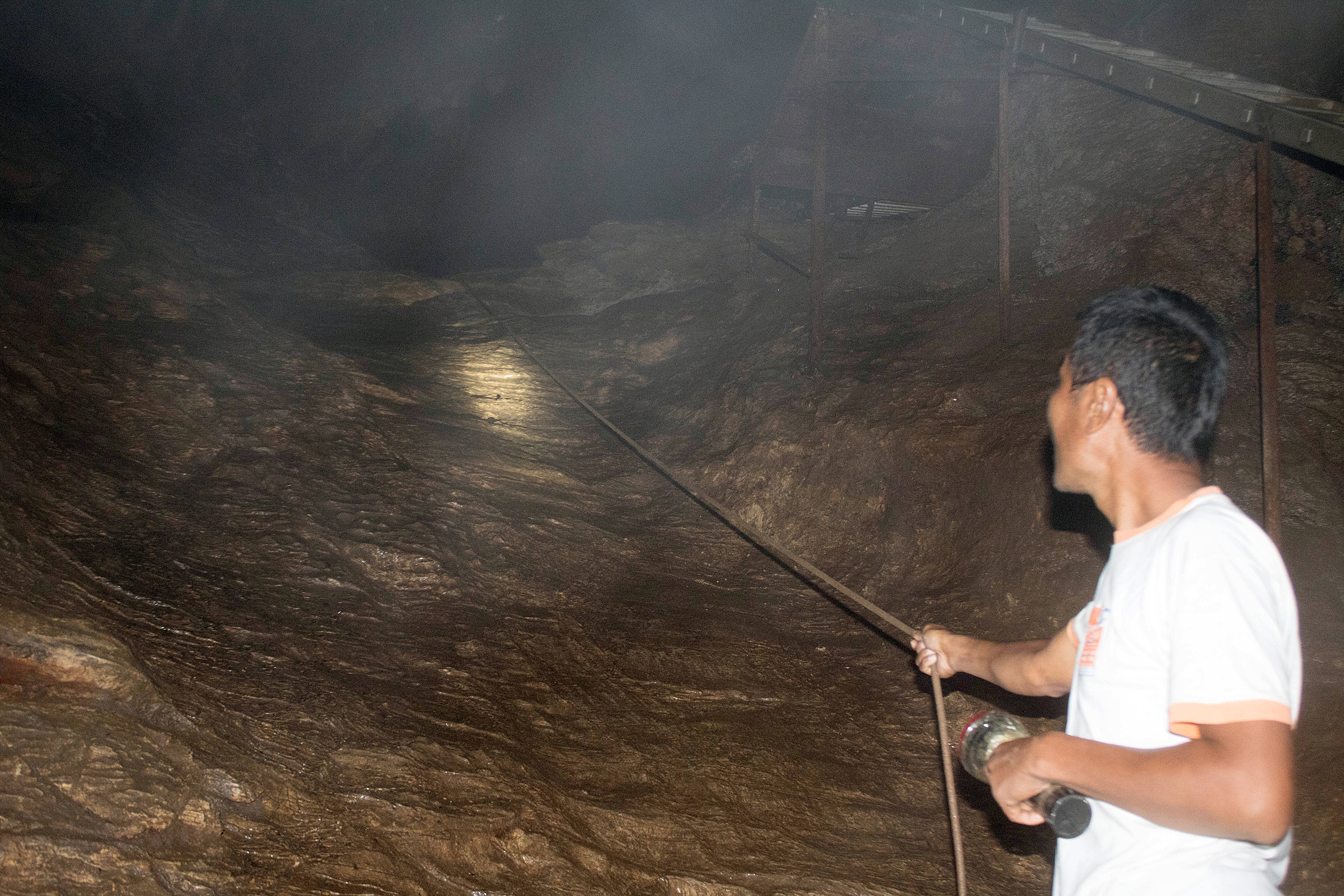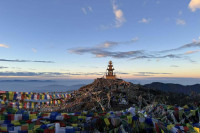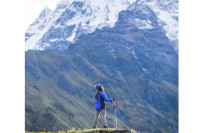Travel
Finding faces in Siddha Gufa
Apparently the largest cave in the country, this hole in the earth sits quietly below Bandipur.
Thomas Heaton
Sanu stops and points his flashlight upward. A relatively nondescript rock juts from the wall, tracing a shadow against the roof of the cave. Tailing nimble Sanu, one of the assigned guides, I wearily slip and slide into the cave. Just a few metres in, light disappears. Bats flitter overhead, their squeaks and squeals echo through the damp and dark chamber. By now we’re about 100 metres into the cave, supposedly the second largest in South Asia and largest in Nepal, Sanu says the outlying rock on the roof is “baagh ko tauko”.
Pointing to the rock’s shadow on the limestone ceiling, finding the feline similarities is like cloud-spotting, so any likeness seems subjective. But, what follows is a mineral-based wild-life spotting pursuit—elephant and snakeheads formed out of icicle-like stalagmite, butterflies traced by striated rock and turtleheads formed from stalactite.
The cave sits above Bimalnagar, about halfway up the trail to Bandipur, a hill station sitting between Pokhara and Kathmandu. It’s just short of an hour’s walk up to Siddha Gufa, but it is not necessarily easy. By the time I reach the cave my legs have already betrayed me. It would be unfair to call the upward route a trek, given it follows paved staircases, but it is basically vertical.
It’s just over 300 metres above Prithvi Highway, and it’s clearly signposted, but deserted except for those who walk down from Bandipur, a more intelligent and less strenuous pursuit. Those people who come from Bandipur are few, however, as this cave seems to be a secondary option to relaxing in the village. Muscles fermenting in all the lactic acid pumping through them from the walk up, the idea of sloping down a cavernous hole does not appeal—cooler climes does, however.

Bracing air wafts from the entrance, where a sadhu and a handful of local people greet visitors, where people pay Rs 200 to be guided through. The limestone walls of the cave, and natural water sources inside, dissipate the suffocating mugginess of the outside climate. The cave looks disappointing from the outside, but the deceptive shallowness betrays its spiritual and literal depths. The safari through the cave, which is 437 metres deep and 50 high, is not just an exercise in finding shapes in stone, however. The animals, with additional faces and figures, are apparently symbols of Shiva—and are treated thusly by pilgrims and worshippers year-round.
Many people come to Bandipur, a peaceful place where clocks don’t seem to exist. While that may be the case, it’s a tourist hot-spot, where the main bazaar is lined almost exclusively with hotels. There are watering holes, and local bhattis where people can try local grog—only if they ask specifically, because it’s not on the menu—and the general mood is one of relaxation.
Most drive the road up to the main bazaar, few trek their way up. Most foreigners are back from Himalayan treks, looking to unwind and let their bodies recover. The days start early, and they finish early too. People trek to the top of the town, to the viewing point, to muse at the massifs for a final time, and they head back to the Valley. The cave, however, feels relatively untouched by tourism.
Ignorant to the realities of the cave, at the time, only knowing that it’s spiritual in some way, I expect a guide in the purest sense—someone to lead the blind ignorant tourist so he doesn’t get lost. It doesn’t take long before we turn back, coming to the cave’s eastern-most end, I expect that we are going to get to the end of the walk—a paltry five-minute walk from the cave’s front. Almost every step of the way is announced and demonstrated by Sanu before taken, with the slippery stone making for a skating experience. The mantra of all Nepali guides, it seems, is once again said: “Bistarai, bistarai”.
A litany of questions is fired at me, the ones I’ve grown used to answering in relative shotgun succession: age, nationality, marital status, salary, weight—just the particulars. Sanu, my ‘saano’ guide through Siddha Cave, would be hardly a dollar soaking wet. A sweat-drenched sorry sight, if we were to appraise my weight, I’d be a million bucks. By the time it seems we should be seeing light, it only gets darker. Sanu points his light downward, which disappears into the ether. He points left, at a rickety shambles of a ‘staircase’. Fashioned from two long painter’s ladders welded to rusty steel poles, the journey downward looks perilous. “Jaam Jaam,” he says, turning around and virtually sliding down. Cautiously spinning and checking every hand hold and step, the slick and muddy ladder seems a kilometre long, as I grasp in the dark.

With each flash of light on the walls one can see the walls’ layers, all subtly different shades of brown and white, while the roof sometimes seems too far away for the light to reach. Clusters of bats cling to the walls, some darting off with the flash of Sanu’s torch.
Once up to the further periphery, it’s lights out. “Meditate,” he says. Confused, I agree and let the darkness consume. It’s scary. It’s darker than night; consciousness without senses. With Sanu’s torch relit, security comes back. And, climbing back up the stairwell, and past a small shrine to Shiva and small shelter built for long-term meditators, the natural light stings the eyes. Blinded by the light, and eager for sight, a fleeted foot leads to a fumble and slip. “Bistarai, bistarai,” Sanu says, laughing. The sadhu fairs the foreigner well, and the chilled sweats start to simmer.
Once out, and on the trail up to Bandipur, few people appear. There’s an elderly couple grazing their cattle, a small group of teenagers on their way to the cave, and the mechanical whirr of cicadas buzzes in and out of earshot. By the time I feverishly don DEET to deal with the scary prospect of dengue, I’m almost at the top. The Marsyangdi River disappears into the distant hills, and the colourful villages look like apiaries, with vehicles flying between.
Eventually, paved stairs hint at Bandipur’s proximity and the faint murmurs of men confirm I’m close. Sitting below the ears of their corn, the younger men listen to the older man’s politics. Leaving the shelter of the forest, and sauntering past through the puddles and mud, Bandipur reveals itself. There’s not a shadow in sight in the sun-drenched village.
***
What do you think?
Dear reader, we’d like to hear from you. We regularly publish letters to the editor on contemporary issues or direct responses to something the Post has recently published. Please send your letters to [email protected] with "Letter to the Editor" in the subject line. Please include your name, location, and a contact address so one of our editors can reach out to you.




 12.99°C Kathmandu
12.99°C Kathmandu








%20(1).jpg&w=300&height=200)

